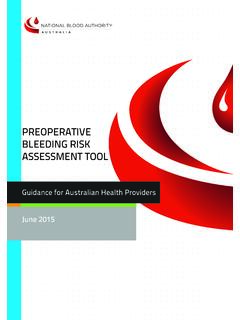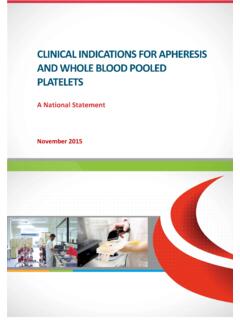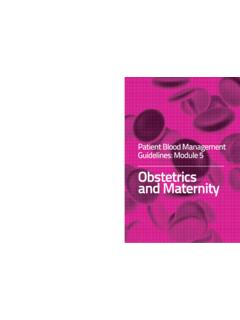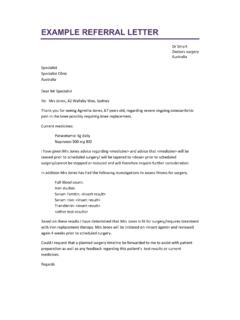Transcription of Managing my iron - Blood
1 Treatment optionsNot having enough iron may make you feel tired or lethargic. Although iron -deficiency anaemia is serious, it can be treated. Improving your iron level will help you feel better. There are a number of options available to help you make sure you have enough Getting enough iron by eating iron -rich foods will help treat iron deficiency but will not be enough on its own. There are two types of iron in foods, haem iron and non-haem iron . Haem iron is more easily absorbed than non-haem iron , however both types can be used by the body. Try to keep up a good intake of iron -rich foods including, for example: haem iron -containing foods lean red meat, offal chicken, fish non-haem iron -containing foods leafy green vegetables, wholemeal bread iron -fortified breakfast cereals legumes, eggsFact SheetIron is needed to make haemoglobin which red Blood cells need to move oxygen around your body.
2 iron is also needed to make myoglobin which helps your muscles store Sheet | Managing my ironManaging my ironEating haem iron -rich foods will increase absorption of non-haem iron . - Include vitamin C-rich foods such as citrus fruit in your diet as it will help your body absorb iron . Oral iron therapy Your doctor may prescribe oral iron if you are at risk of or have iron deficiency. Some people are at higher risk such as: - toddlers, preschool children and adolescents- pregnant women- people with excessive Blood loss - people with conditions such as coeliac diseaseThere are many iron supplements available.
3 Speak with your doctor about which one is best for supplements with iron , such as multivitamin-mineral supplements, do not generally have enough iron to treat iron -deficiency anaemia. Look for supplements that have 60 mg or more of elemental iron (eg, Elevit and Ferro-Grad C).How to get the best out of your iron supplement: You should take your oral iron supplements for 3 6 months until your iron levels return to normal. iron is absorbed best on an empty stomach, but supplements can cause stomach upset. Taking supplements, in a divided dose morning and evening or every second day to start with, with a small amount of food may help you avoid this.
4 Do not take milk or antacids at the same time as your iron supplements. Do not eat high-fibre foods such as whole grains and raw vegetables, or foods containing caffeine such as chocolate or coffee when you take your supplement. These foods can interfere with absorption. Taking a vitamin C supplement, or drinking orange juice with your iron supplement, may help the iron absorb into your iron therapy iron supplements can also be given directly into your vein through a drip (intravenous). Your doctor may prescribe intravenous iron if: you can t take oral iron because you can t tolerate it, or it is not sufficient or effective you have problems with absorbing nutrients from food for example, if you have inflammatory bowel disease, or if you need to increase your iron levels very quickly such as immediately before adviceNPS1477 Fact Sheet | Managing my iron Intravenous iron comes in various forms: iron sucrose, iron polymaltose, ferric carboxymaltose .
5 Your doctor will calculate the dose of intravenous iron based on how severe your iron deficiency is and your body weight. You may experience some side effects such as headache, muscle pain, shortness of breath or a rash. You will be closely monitored while you receive your infusion. If you experience any symptoms either during or after the procedure tell your health professional right for surgeryYour doctor may give you advice about iron therapy if you have planned surgery. Improving your iron levels before surgery may help avoid the need for a Blood transfusion. A Blood transfusion after surgery may mean your recovery is information is not intended to take the place of medical advice and you should seek advice from a qualified health professional.
6 Reasonable care is taken to provide accurate information at the date of creation. Where permitted by law, NPS MedicineWise and the National Blood Authority disclaims all liability (including for negligence) for any loss, damage or injury resulting from reliance on or use of this 8217 870002 9211 7578 not-for-profit and evidence based, NPS MedicineWise enables better decisions about medicines and medical tests. We are funded by the Australian Government Department of Health. 2014 National Prescribing Service Limited ABN 61 082 034 393 Level 7/418A Elizabeth St Surry Hills NSW 2010 PO Box 1147 Strawberry Hills NSW 2012 Published September 2015.











